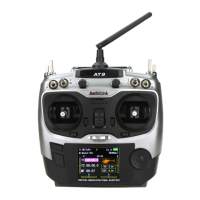The THR-DELAY function is used to slow the response of the throttle servo to simulate the slow
response of a turbine engine. A 40% delay setting corresponds to about a one-second delay, while a 100%
delay takes about eight seconds to respond. This function may also be used to create a “slowed servo” on a
channel other than throttle. This is accomplished by plugging the desired servo (Ex: gear doors) into CH3
(THR), throttle into an auxiliary channel such as 8, and then using some creative mixes.
Activate
THR-DELAY for a
ducted-fan replica of
a turbine-powered
aircraft.
Slow the servo
response by one
second.
to BASIC . again to ADVANCE
to THR-DELAY,
Adjust the RATE to match the
desired servo speed.(Ex:40%)
3.3.14 THR CURVE (ACRO)
This function adjusts the throttle operation curve for optimum the engine speed to throttle stick movement.
Note: If the throttle EXP function is activated, you can not use THR-CURVE function simultaneously.
Adjustability:
• Separate curves for each switch position are available.
• Moving and deleting the curve point: The curve point (-stk-) can be moved to the left or right by turning the
DIAL (up to 2% in front of the adjoining point) and deleted/returned by pressing the DIAL for one second
alternately.
Base point: Adjust
base point of throttle
curve until engine
idles reliably.
-Out-:output,servo
position.
-STK-: curve point,
stick position.
to BASIC . again to ADVANCE
to THE-CURVE,
to P1(-out-).PUSH to desired servo position
Optional:assign the switch.
to SW.PUSH, to desired switch.
Optional: Move the curve
point.(Ex:point 3)
to P3 (-stk-),PUSH to desired curve point to
move to left or right.

